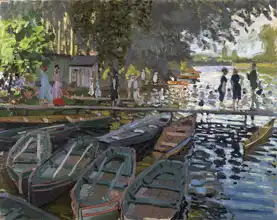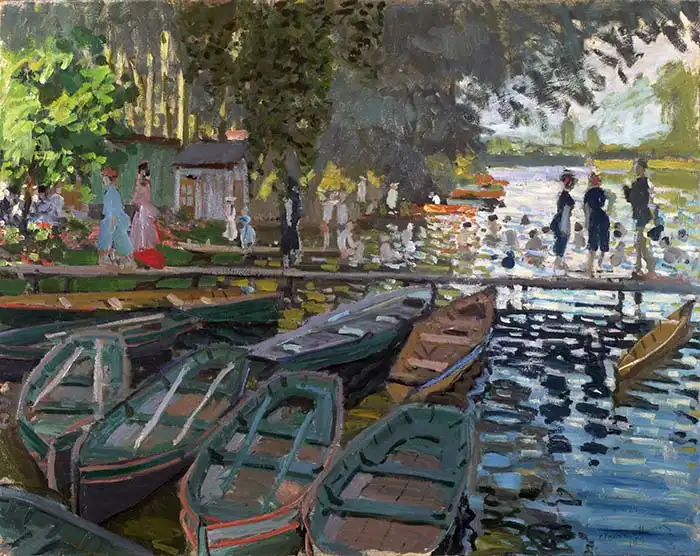About this finishing
Print. The image is printed on the top quality 10-ink HP Z9PS printer on HP matte 270 g / m2 paper. You can choose any size to an accuracy of 1 cm. A margin of 5 cm around the image is added to the size of the motif.


You can find a detailed description about our finishings
here.
Bathing at La Grenouillere
Date:
1869Medium:
oil on canvasLocation:
National Gallery, London, UKDimensions:
73 x 92"Bathing at La Grenouillère" is a famous painting by the French
impressionist painter
Claude Monet , created in 1869. This painting depicts life on the Seine River at a famous entertainment, restaurant and beach area called "La Grenouillère, " which was a favorite place for Parisians during the 19th century. In the painting "Bathing at La Grenouillere" you can see the river Seine, which stretches in the middle of the composition. On the left bank of the river is the restaurant "La Grenouillère," which was the central point of this popular recreational area. Its roof is decorated with flags and colorful umbrellas, which gives the picture a cheerful and summery atmosphere. On the right bank of the river there is a beach where the figures can be seen. In an impressionistic manner, Monet captures these figures bathing or resting on the shore. The painter paid attention to light reflections on water and on floating ships, which is a characteristic feature of his work. Reflections can be seen on the water surface of the Seine, making the water appear to be constantly moving.
Monet used light and color to capture the impression of moment and movement. The painting is full of bright colors, which was typical of the Impressionist style, and creates an impression of light and life.
Monet painted picture Bathing at La Grenouillere in 1869. Prevailing color of this fine art print is green and its shape is landscape. Original size is 73 x 92. This art piece is located in National Gallery, London, UK. This image is printed on demand - you can choose material, size and finishing.
Claude Oscar Monet (1840-1926). A native Parisian, who thoroughly developed the idea of
Impressionism. Monet almost scientifically studied the effect of light on different objects. He devoted himself to so called transitory states, which quickly led him to work with colour and light, his paintings acting on the viewer from the first impression. His use of open-air painting and objects which were special only because of light opened the way for the beginnings of modern painting. Monet’s
Impression, Sunrise (1874) not only gave the name to the whole art movement, but secured Monet a place among the best painters of all times. At one time, he resided in London and created his famous study
Houses of Parliament (Monet wondered, How could the English painters paint Parliament when it cannot be seen for the fog?). In the
Giverny, which became his favourite retreat after the death of his wife, he painted motifs from his garden and the popular series
Water Lilies - the world of the water was as poetic and mysterious as a primordial paradise.


